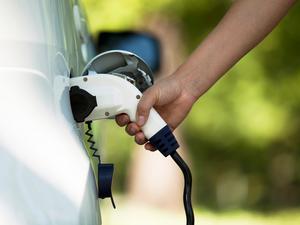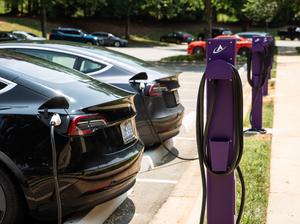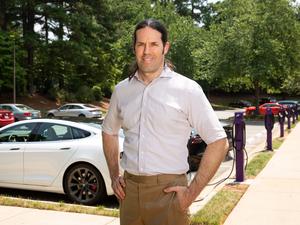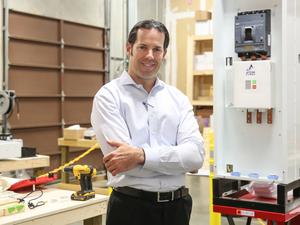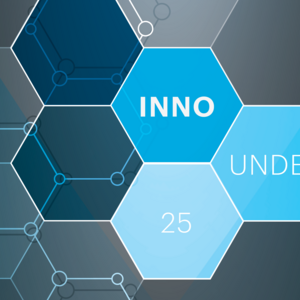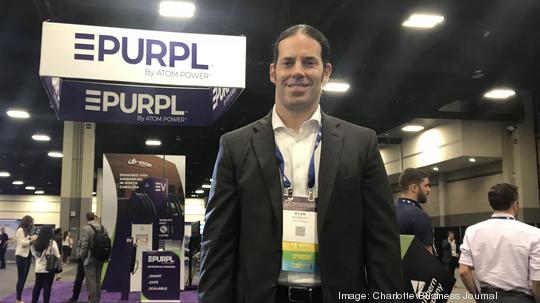
Homegrown startup Atom Power Inc. has moved into its 21,000-square-foot office and manufacturing facility in Huntersville, where it is producing its trademark Purpl electric-vehicle charging system.
And the company is on the verge of another large expansion. By the end of the month, says CEO Ryan Kennedy, the company will complete its fourth — and final — round of private capital raising. The company has completed three rounds to date since it was founded in 2014.
It has raised $30 million in those equity offerings, and the current round will be larger than all of them combined, Kennedy says. He won’t disclose the amount until the funding round is complete, he says. But the money will allow the company to shift from focusing largely on developing technology to becoming a force in the EV-charging market.
Kennedy started Atom Power to produce the first commercially available digital circuit breaker. It is hundreds of times safer, thousands of times faster and almost infinitely more flexible than the traditional mechanical circuit breakers you find in every electrical system.
It has several applications in addition to replacing its mechanical counterparts, but ultimately, Kennedy has focused the company on EV charging. He says the Purpl system has a major advantage over traditional EV chargers. It avoids the need for building expensive components into each individual charging station, running an increasing number of stations from a single bank of smart circuit breakers which can control, for instance, an entire business fleet of electric vehicles.
Also, the smart breakers make the system handle enormous charging demand with significantly less expensive electrical infrastructure than traditional chargers.
In preparing for that transition to market-driven company, Atom Power was a principal sponsor of the recent Electrification 2022 conference staged by the Electric Power Research Institute in Charlotte. It is Atom Power’s first big stab at raising its visibility in the market.
The Charlotte Business Journal caught up with Kennedy there and talked about where Atom Power and its current 57 employees are now and where they are headed.
A third party has recently started a demonstrator project to put a lot of Purpl EV chargers in an office parking deck. What is that about?
There is often a chicken-and-egg scenario with the property management firms on how to put in electric-vehicle infrastructure and when. So, what (the unnamed partner) is doing is proactively spending his own money to install EV chargers at his location to demonstrate the usage.
What we're finding is, for those who have put EV chargers in any of the decks, they're almost always 100% occupied. That means there's not enough supply for the demand.
So, he's demonstrating the use case and the traffic flow, based on EV charging, and demonstrating that to various property managers within the Charlotte metro area from a parking deck perspective.
Parking decks right now have a couple here and there. But what's going to be required in the future — and we know this because some of the building owners and property developers all say the same thing — there's going to need to be a lot of chargers. But no one knows how to pull the trigger, when to pull the trigger, or who has the authority to pull the trigger.
Is the general market getting past the chicken-and-egg issue?
There’s still a problem in some sectors. Fleets and multifamily housing are particularly good examples of that. In the case of multifamily, a lot of larger multifamily projects know that EVs are coming and they're going to have to offer charging as an amenity to tenants. But no one knows when.
What we're seeing now on some of the higher-end multifamily — we know two right now in the Charlotte metro area, large multifamily complexes that are actively losing tenants because of the lack of electric-vehicle infrastructure.
We're seeing the same in hotels. Customer choices are made on whether they have electric-vehicle charging infrastructure sitting there. I've made that choice in my travels, right? Because if I'm going to drive 600 miles, I can stop at highway chargers along the way.
But once you get there, you're going to be sitting for a while. And then you may want to take a drive 10 miles here, 5 miles there. You just want to be able to have juice in the vehicle once you're there at your destination.
So, what will give them the final push?
I think there are economics driving those multifamily and hospitality groups into realizing the value of having electric-vehicle infrastructure. The scale is what's chicken or egg. Do you just put all the parking spaces as EV charging? No, it's, "Let's first start here; let's add more than a few chargers." This is where Atom Power comes in because that's where we play — in the "more than a few chargers" market and then scale out from there as the adoption rate increases.
What are the milestones coming up for Atom Power?
We have one more funding round closing now, actually, within a matter of weeks. And that's our last one, you know, outside of going public — which may or may not be in the cards.
And this capital raise now, what it does is it compels us to a different level. It's been a journey for Atom Power. It's almost two different stories entirely. The first five years were pure tech development — do something no one else is doing for these reasons and have an impact in the market.
Here more recently, in the last two years, we've had to transition into a market-driven company. Let's actually have economic impact based on what we've created here. Which is why the emphasis and the target is on (EV) infrastructure. It's a high-growth market, high impact to the environment and to society and everything else.
But we're still very largely a technology company. I think 75%-plus of our employees are engineers. So, we're soon going to be shifting dramatically into a market-driven company.
How much are you looking to raise, or have you filed a Form D (securities filing to disclose private funding rounds)?
We haven't yet. All this is closing within the next two weeks. It's a big one, though.
Significantly more than you've raised in the past?
We've had some convertible notes along the way, but just in equity, all in, at this point it's right at $30 million. And this one will be larger than the $30 million raised so far.
So why have you sponsored this expo for the first time?
It's that transition, at least the first step to getting out proactively, which is really what we haven't done much. We've been very reactive from the sales perspective — fielding calls, taking orders, things like that.
Another part on why go big on this one? It’s because everything here is in our wheelhouse. Everything is energy delivery and it's in Charlotte. It makes a lot of sense. If we're going to grow in the space of proactive business development sales we need to do it in our own backyard.
There are automakers here, there are utilities here. Are these people talking to you?
Yeah, it's been a very healthy expo so far. And the thing is, what's interesting about it ... is right now, the EV market in general is highly dysfunctional. And dysfunctional doesn't mean bad thing. It just means it's extremely chaotic, like how you do things? When you do things? Who does what? Who's ultimately going to win? You have so many different EV chargers alone, not to mention software packages, the charge-point operator packages. It reminds me of the 1997 internet. That's where the market is today. We're at Lycos, Excite, Netscape (all early web portals) — seriously, that's the market right now. It's not sure what model is going to truly win and be scalable.
How does Atom Power play into that need for a clear charging model?
It’s not just from a product standpoint. It's from the philosophical approach. The approach to EV charging has been relegated to a widget — a thing that charges the car. Our view comes from the power-distribution industry.
Our view is, "Yeah, there is a thing you plug in. But to charge vehicles at scale, you have to have intelligent infrastructure."
Ultimately, the technology will get commoditized, regardless of the best technology. So, what's ultimately going to win for everyone is going to be the business model around EV charging. The bigger question is, how can everyone win? And that's the biggest barrier right now. How does the multifamily landlord get a payback for that infrastructure? How does a tenant win? How does the manufacturer like Atom Power win? It's business model that's ultimately going to win.
